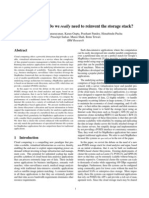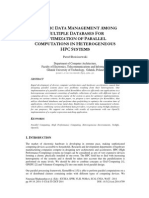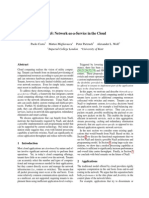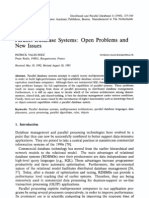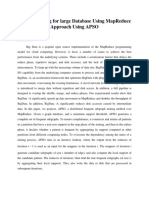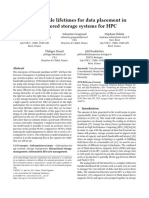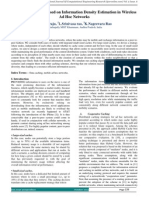0 ratings0% found this document useful (0 votes)
17 viewsDatacenter Storage Architecture For Mapreduce Applications: Jeffrey Shafer, Scott Rixner, Alan L. Cox Rice University
Datacenter Storage Architecture For Mapreduce Applications: Jeffrey Shafer, Scott Rixner, Alan L. Cox Rice University
Uploaded by
hamidsa81The document proposes a new storage architecture for MapReduce applications that decouples computation and storage resources. It argues that upcoming advances in converged datacenter networks allow removing disks from compute nodes and connecting them directly to switches. This provides more flexible resource allocation while maintaining equivalent performance. The key points that enable this are the streaming access patterns of MapReduce applications and high-performance switches with low latency. Preliminary experiments show equivalent performance between local and remote storage architectures.
Copyright:
© All Rights Reserved
Available Formats
Download as PDF, TXT or read online from Scribd
Datacenter Storage Architecture For Mapreduce Applications: Jeffrey Shafer, Scott Rixner, Alan L. Cox Rice University
Datacenter Storage Architecture For Mapreduce Applications: Jeffrey Shafer, Scott Rixner, Alan L. Cox Rice University
Uploaded by
hamidsa810 ratings0% found this document useful (0 votes)
17 views3 pagesThe document proposes a new storage architecture for MapReduce applications that decouples computation and storage resources. It argues that upcoming advances in converged datacenter networks allow removing disks from compute nodes and connecting them directly to switches. This provides more flexible resource allocation while maintaining equivalent performance. The key points that enable this are the streaming access patterns of MapReduce applications and high-performance switches with low latency. Preliminary experiments show equivalent performance between local and remote storage architectures.
Original Description:
Original Title
9c960529620ba0ca69
Copyright
© © All Rights Reserved
Available Formats
PDF, TXT or read online from Scribd
Share this document
Did you find this document useful?
Is this content inappropriate?
The document proposes a new storage architecture for MapReduce applications that decouples computation and storage resources. It argues that upcoming advances in converged datacenter networks allow removing disks from compute nodes and connecting them directly to switches. This provides more flexible resource allocation while maintaining equivalent performance. The key points that enable this are the streaming access patterns of MapReduce applications and high-performance switches with low latency. Preliminary experiments show equivalent performance between local and remote storage architectures.
Copyright:
© All Rights Reserved
Available Formats
Download as PDF, TXT or read online from Scribd
Download as pdf or txt
0 ratings0% found this document useful (0 votes)
17 views3 pagesDatacenter Storage Architecture For Mapreduce Applications: Jeffrey Shafer, Scott Rixner, Alan L. Cox Rice University
Datacenter Storage Architecture For Mapreduce Applications: Jeffrey Shafer, Scott Rixner, Alan L. Cox Rice University
Uploaded by
hamidsa81The document proposes a new storage architecture for MapReduce applications that decouples computation and storage resources. It argues that upcoming advances in converged datacenter networks allow removing disks from compute nodes and connecting them directly to switches. This provides more flexible resource allocation while maintaining equivalent performance. The key points that enable this are the streaming access patterns of MapReduce applications and high-performance switches with low latency. Preliminary experiments show equivalent performance between local and remote storage architectures.
Copyright:
© All Rights Reserved
Available Formats
Download as PDF, TXT or read online from Scribd
Download as pdf or txt
You are on page 1of 3
Datacenter Storage Architecture for MapReduce Applications
Jeffrey Shafer, Scott Rixner, Alan L. Cox
Rice University
{shafer, rixner, alc}@rice.edu
Abstract
Data-intensive computing systems running MapReduce-
style applications are currently architected with storage lo-
cal to computation in the same physical box. This poster
argues that upcoming advances in converged datacenter net-
works will allow MapReduce applications to utilize and ben-
et from network-attached storage. This is made possible
by properties of all MapReduce-style applications, such as
streaming storage access patterns. By decoupling compu-
tation and storage, stateless compute nodes containing in-
expensive, low-power processors can be deployed in large
numbers to increase application performance, improve re-
liability, and decrease power consumption.
1 Introduction
Data-intensive problems exist today in the domains of
commerce, science, and engineering. These problems
are solved only by writing applications that leverage the
power of thousands of processors to manipulate data sets
ranging in size from hundreds of terabytes to dozens of
petabytes. Such applications can only be run in the data-
center, where they can take advantage of computation,
storage, power, and cooling resources on a large scale [2].
A new programming model called MapReduce has
emerged to support these data-intensive applications. Pro-
grams are divided into a map function and a reduce func-
tion. The map function takes a key/value pair and pro-
duces one or more intermediate key/value pairs. The re-
duce function takes these intermediate pairs and merges
all values corresponding to a single key. Both of these
stages can run independently on each key/value pair, ex-
posing enormous amounts of parallelism. In a MapRe-
duce application, a middleware layer (such as Yahoos
Hadoop) is responsible for distributing the parallelized
computation to a large pool of loosely-synchronized pro-
cessors and aggregating the results.
MapReduce-style applications use a different storage
architecture than traditional datacenter applications such
as transactional processing, which commonly use a cen-
tralized data store accessed across the network. A key
premise for MapReduce-style computing systems is that
there is insufcient network bandwidth to move the data
to the computation, and thus computation must move to
the data instead [2]. Based on the assumption that remote
data can only be accessed with low bandwidth and high
latency, current MapReduce architectures co-locate com-
putation and storage in the same physical box, as shown
in Figure 1. Storage is accessible across the network via
a global le system that provides replication and load bal-
ancing. However, the MapReduce framework attempts to
migrate computation to use data on locally-attached disks
whenever possible.
Upcoming advances in converged network fabrics will
enable a more exible storage architecture for MapRe-
duce applications without any loss of efciency. Con-
verged network technologies have previously focused on
allowing applications to access existing storage-area net-
works without either transiting a front-end storage server
or using a dedicated storage network adaptor. In contrast,
we advocate using such converged networks to decou-
ple computation and storage for MapReduce. The net-
work properties provided by quality-of-service and loss-
less ow control protocols will allow disks to be removed
from the compute nodes and instead attached to switches
throughout the datacenter. No dedicated storage-area net-
work will be required. Properties of MapReduce applica-
tions will allow this decoupling of computation from stor-
age while maintaining equivalent performance, enabling a
more exible and efcient datacenter design.
2 Datacenter Architecture
We advocate a new storage architecture for MapReduce in
the datacenter that incorporates remote storage, as shown
in Figure 2 for a single rack. This design employs net-
worked disks simple unstructured block storage devices
connected to the network [3] along with the use of a
converged network to decouple storage resources from
computation resources. Compute nodes are equipped with
1
processors but not disks, and storage nodes are equipped
with disks but are not used for computation. Instead of
co-locating storage and computation in the same box as in
the traditional MapReduce storage architecture, this de-
sign co-locates storage and computation on the same Eth-
ernet switch.
The advantages of using remote disks in a datacenter
are numerous. First, both computation and storage re-
sources can be adjusted to meet application requirements
during both cluster construction and operation. Second,
computation and storage failures are decoupled from each
other. This eliminates wasted resources that would have
been used to reconstruct lost storage when a computation
node fails. Third, ne-grained power management tech-
niques can be used, whereby compute and storage nodes
are enabled and disabled to meet current application re-
quirements. Finally, because computation is now an in-
dependent resource, a mix of both high and low power
processors can be deployed. The runtime environment
managing application execution can change the proces-
sors being used for a specic application in order to meet
administrative power and performance goals.
3 MapReduce and Remote Storage
MapReduce frameworks such as Hadoop make an explicit
assumption that storage is local to computation. However,
a fresh look at the architecture reveals that these resources
can be decoupled and connected merely to the same net-
work switch. This is made possible for two major reasons:
First, MapReduce applications use storage in a manner
that is different than ordinary applications. Data is typi-
cally stored in large blocks (e.g. 64MB) and accessed us-
ing a simple write-once, read-many coherence model [1].
Application performance depends more on the bandwidth
to access entire blocks than the latency to access any par-
ticular element in a block. Furthermore, data is accessed
in a streaming pattern, rather than random access. This
allows storage requests to be pipelined and data to be
streamed across the network, minimizing any effect from
network latency.
Second, modern network switches offer extremely high
performance. A typical 48- or 96-port Ethernet switch
provides the full bisection bandwidth across its switching
fabric, allowing an entire rack of hosts to communicate
with each other at full network speed. If more bandwidth
is needed, link aggregation can be used to connect multi-
ple Gigabit links to the same host. Modern switches also
have low latency under 2us for a minimum-sized Eth-
ernet frame and emerging cut-through fabrics promise
to reduce latency further. Compared to hard disk seek la-
tencies measured in milliseconds, the forwarding latency
of modern switches is negligible
1
. Thus, high perfor-
mance switches add minimal overhead to remote storage
accesses that are located in the same rack as the compu-
tation node. By combining modern network switches and
a streaming access pattern, remote disks can potentially
achieve throughputs approaching that of local disks.
We have tested this proposed architecture on a small
scale using a cluster computer running the Hadoop
MapReduce framework. This cluster was congured in
two ways: First, using disks installed in the compute
nodes, and second, moving those same disks to other non-
compute nodes attached to the same Ethernet switch. In
the second case, the lightweight ATA-over-Ethernet pro-
tocol was used to export each disk across the network as
a low-level block storage device with minimal overhead.
Preliminary experiments conducted using data-intensive
benchmarks such as a random data generator showed that
the decoupled storage architecture had equivalent perfor-
mance to the local storage architecture.
4 Conclusions
We propose a new architecture for MapReduce applica-
tions that decouples computation from storage by using a
converged network and networked disks. Removing the
disks provides an opportunity for more exible and ef-
cient datacenter design. The ratio between computation
and storage resources can be changed both during data-
center construction and dynamically during operation to
meet application performance and power requirements.
Clusters can also be equipped with a mix of computa-
tion nodes containing either high-performance (i.e., Intel
Xeon) or high-efciency (i.e., Intel Atom) processors, al-
lowing applications to select the performance and power
mix that is desired.
References
[1] HDFS (hadoop distributed le system) architecture.
http://hadoop.apache.org/core/docs/
current/hdfs_design.html, 2008.
[2] R. E. Bryant. Data-intensive supercomputing: The case for
DISC. Technical Report CMU-CS-07-128, Carnegie Mel-
lon University, May 2007.
[3] Gibson et al. A cost-effective, high-bandwidth storage ar-
chitecture. In ASPLOS-VIII, 1998.
1
Even solid-state disk latencies are much higher than network
switching latencies. Regardless, conventional disks are still the likely
choice for MapReduce datacenter storage due to capacity and cost.
2
5 Appendix
Figure 1: Local-Storage Architecture (Single Rack)
Figure 1 shows the storage architecture for a traditional datacenter running a MapReduce framework such as
Hadoop. In this architecture, data is stored on disks local to the processors. Although the data is accessible over
the network, computation is migrated to the data whenever possible.
Figure 2: Remote-Storage Architecture (Single Rack)
Figure 2 shows the proposed remote storage architecture. In this datacenter, storage is provided by network-attached
disks connected to the same network switch as the compute nodes.
3
You might also like
- Jemstar II High Accuracy Revenue Meter 5-11Document4 pagesJemstar II High Accuracy Revenue Meter 5-11Pritam SinghNo ratings yet
- Cloud Analytics Do We Really Need To Reinvent The Storage StackDocument5 pagesCloud Analytics Do We Really Need To Reinvent The Storage Stackcoolsuhas19No ratings yet
- Dynamic Data Management AmongDocument11 pagesDynamic Data Management AmongCS & ITNo ratings yet
- Networking in The Hadoop ClusterDocument5 pagesNetworking in The Hadoop ClusterMarcos SCNo ratings yet
- Naas: Network-As-A-Service in The CloudDocument6 pagesNaas: Network-As-A-Service in The CloudManu BansalNo ratings yet
- Tesseract Pim Architecture For Graph Processing - Isca15Document13 pagesTesseract Pim Architecture For Graph Processing - Isca15Megha JoshiNo ratings yet
- Parallel DB IssuesDocument29 pagesParallel DB IssuesVarsha BhoirNo ratings yet
- MM 3Document11 pagesMM 3Doğuş KantarciNo ratings yet
- 6445 An Introduction Red Hat Storage ArchitectureDocument12 pages6445 An Introduction Red Hat Storage ArchitecturesweetsonNo ratings yet
- Report Title: Wasit UniversityDocument8 pagesReport Title: Wasit Universitybassam lateefNo ratings yet
- Resilient Distributed Datasets: A Fault-Tolerant Abstraction For In-Memory Cluster ComputingDocument18 pagesResilient Distributed Datasets: A Fault-Tolerant Abstraction For In-Memory Cluster ComputingSandraPereraNo ratings yet
- Abstract Cloud Computing Is An Emerging Paradigm That Provides ComputingDocument8 pagesAbstract Cloud Computing Is An Emerging Paradigm That Provides ComputingSudhansu Shekhar PatraNo ratings yet
- Cluster Based Load Rebalancing in CloudsDocument5 pagesCluster Based Load Rebalancing in CloudsVanu ShaNo ratings yet
- LSJ1347 - Load Rebalancing For Distributed File Systems in CloudsDocument4 pagesLSJ1347 - Load Rebalancing For Distributed File Systems in CloudsSwathi ManthenaNo ratings yet
- Efficient Datapath Merging For Partially Reconfigurable ArchitecturesDocument12 pagesEfficient Datapath Merging For Partially Reconfigurable ArchitecturesHacı AxundzadəNo ratings yet
- The VPC Offers The Function of The PrivateDocument3 pagesThe VPC Offers The Function of The PrivatedaliasobhiNo ratings yet
- 2009 Dfs HotpowerDocument5 pages2009 Dfs HotpowerNazriel66No ratings yet
- BDEv3.5 Perf. Benchmark and Architect DesignDocument28 pagesBDEv3.5 Perf. Benchmark and Architect DesignSontas JiamsripongNo ratings yet
- Splits Input Into Independent Chunks in Parallel MannerDocument4 pagesSplits Input Into Independent Chunks in Parallel MannerSayali ShivarkarNo ratings yet
- Ijirt147527 PaperDocument6 pagesIjirt147527 PaperPI CubingNo ratings yet
- Key Ideas Behind Mapreduce 3. What Is Mapreduce? 4. Hadoop Implementation of Mapreduce 5. Anatomy of A Mapreduce Job RunDocument27 pagesKey Ideas Behind Mapreduce 3. What Is Mapreduce? 4. Hadoop Implementation of Mapreduce 5. Anatomy of A Mapreduce Job RundanisorNo ratings yet
- Cluster Computing: DATE: 28 November 2013Document32 pagesCluster Computing: DATE: 28 November 2013Hasan BadirNo ratings yet
- Data Similarity-Aware Computation Infrastructure For The CloudDocument14 pagesData Similarity-Aware Computation Infrastructure For The CloudAjay TaradeNo ratings yet
- U4S9Document18 pagesU4S9shubham gupta (RA1911004010290)No ratings yet
- Coacs: A Cooperative and Adaptive Caching System For ManetsDocument17 pagesCoacs: A Cooperative and Adaptive Caching System For ManetsramasamyNo ratings yet
- Efficient Query Processing Framework For Big Data Warehouse - An Almost Join-Free ApproachDocument13 pagesEfficient Query Processing Framework For Big Data Warehouse - An Almost Join-Free ApproachEttaoufik AbdelazizNo ratings yet
- Outer Space An Outer Product Based Sparse Matrix Multiplication AcceleratorDocument13 pagesOuter Space An Outer Product Based Sparse Matrix Multiplication Accelerator陳威宇No ratings yet
- Infrastructure ArchitecturingDocument8 pagesInfrastructure ArchitecturingaplatoonNo ratings yet
- End-To-End Optimization For Geo-Distributed MapreduceDocument14 pagesEnd-To-End Optimization For Geo-Distributed MapreduceamarmudirajNo ratings yet
- Parasplit: A Scalable Architecture On Fpga For Terabit Packet ClassificationDocument8 pagesParasplit: A Scalable Architecture On Fpga For Terabit Packet ClassificationDevNo ratings yet
- Chapter One 1.1 Background of StudyDocument15 pagesChapter One 1.1 Background of StudyamehNo ratings yet
- Data Processing For Large Database Using Mapreduce Approach Using ApsoDocument59 pagesData Processing For Large Database Using Mapreduce Approach Using ApsosumankumarNo ratings yet
- Improving The Performance of Heterogeneous Hadoop Cluster-2016Document6 pagesImproving The Performance of Heterogeneous Hadoop Cluster-2016bcogbiprasadNo ratings yet
- Hadoop: A Seminar Report OnDocument28 pagesHadoop: A Seminar Report OnRoshni KhairnarNo ratings yet
- Cluster ComputingDocument5 pagesCluster Computingshaheen sayyad 463No ratings yet
- MAP-JOIN-REDUCE: Toward Scalable and Efficient Data Analysis On Large ClustersDocument13 pagesMAP-JOIN-REDUCE: Toward Scalable and Efficient Data Analysis On Large ClustersDev DangNo ratings yet
- Parallel Computing Based Distribution Network - Reliability Evaluation Technology ResearchDocument6 pagesParallel Computing Based Distribution Network - Reliability Evaluation Technology ResearchSudiharyantoLikaNo ratings yet
- The Tera Computer SystemDocument6 pagesThe Tera Computer Systemsike1977No ratings yet
- Sum Product PaperDocument10 pagesSum Product PaperpeoriditoNo ratings yet
- CSE 423 Virtualization and Cloud Computinglecture0Document16 pagesCSE 423 Virtualization and Cloud Computinglecture0Shahad ShahulNo ratings yet
- BDA Module2-Chapter1Document21 pagesBDA Module2-Chapter1Lahari bilimaleNo ratings yet
- Parallel DbmsDocument5 pagesParallel DbmsRohit BhutaniNo ratings yet
- Research and Realization of Reflective Memory Network: 1. AbstractDocument56 pagesResearch and Realization of Reflective Memory Network: 1. AbstractAtul KumbharNo ratings yet
- The Tera Computer SystemDocument6 pagesThe Tera Computer SystemJohn WestonNo ratings yet
- A Model-Based Algorithm For Optimizing I/O Intensive Applications in Clouds Using VM-Based MigrationDocument6 pagesA Model-Based Algorithm For Optimizing I/O Intensive Applications in Clouds Using VM-Based MigrationLarry SmithNo ratings yet
- A-Tree: Distributed Indexing of Multidimensional Data For Cloud Computing EnvironmentsDocument3 pagesA-Tree: Distributed Indexing of Multidimensional Data For Cloud Computing EnvironmentsAsoUmeNo ratings yet
- A Cost-Efficient Data Placement Algorithm-2017Document6 pagesA Cost-Efficient Data Placement Algorithm-2017bcogbiprasadNo ratings yet
- SystemModelsforDistributedandCloudComputing PDFDocument15 pagesSystemModelsforDistributedandCloudComputing PDFRavinderNo ratings yet
- Distributed Database Management Systems and The Data GridDocument12 pagesDistributed Database Management Systems and The Data Gridselvaraj.MNo ratings yet
- Research Paper 6 2021Document9 pagesResearch Paper 6 2021Shubham PitaleNo ratings yet
- System Models For Distributed and Cloud ComputingDocument22 pagesSystem Models For Distributed and Cloud Computingchamp riderNo ratings yet
- Map Reduce On Red Green Blue ArchitectureDocument11 pagesMap Reduce On Red Green Blue ArchitectureInternational Journal of Innovative Science and Research TechnologyNo ratings yet
- Socc11 Cluster SizingDocument14 pagesSocc11 Cluster SizingArun ThomasNo ratings yet
- Caching Strategies Based On Information Density Estimation in Wireless Ad Hoc NetworksDocument7 pagesCaching Strategies Based On Information Density Estimation in Wireless Ad Hoc NetworksInternational Journal of computational Engineering research (IJCER)No ratings yet
- Programming Your Network at Run-Time For Big Data ApplicationsDocument6 pagesProgramming Your Network at Run-Time For Big Data ApplicationsSamNo ratings yet
- A Gossip Protocol For Dynamic Resource Management in Large Cloud EnvironmentsDocument13 pagesA Gossip Protocol For Dynamic Resource Management in Large Cloud EnvironmentsNamith DevadigaNo ratings yet
- Tez Design v1.1Document15 pagesTez Design v1.1dressguardNo ratings yet
- Evaluation of Data Processing Using Mapreduce Framework in Cloud and Stand - Alone ComputingDocument13 pagesEvaluation of Data Processing Using Mapreduce Framework in Cloud and Stand - Alone ComputingsharathNo ratings yet
- Scalable Aggregation On Multicore ProcessorsDocument9 pagesScalable Aggregation On Multicore ProcessorsNorases VesdapuntNo ratings yet
- Hadapt White Paper Technical OverviewDocument6 pagesHadapt White Paper Technical Overviewur_sriNo ratings yet
- Main Page: Welcome To The Mikrotik Wiki!Document2 pagesMain Page: Welcome To The Mikrotik Wiki!hamidsa81No ratings yet
- RAILWAY Ethernet TrainDocument4 pagesRAILWAY Ethernet Trainhamidsa81No ratings yet
- Sla IaagDocument5 pagesSla Iaaghamidsa81No ratings yet
- AMG1202-T10A: Quick Start GuideDocument12 pagesAMG1202-T10A: Quick Start Guidehamidsa81No ratings yet
- High Speed 802.11n ADSL2+ Wireless Gateway: BenefitsDocument2 pagesHigh Speed 802.11n ADSL2+ Wireless Gateway: Benefitshamidsa81No ratings yet
- Book Reviews: Build The Best Data Center Facility For Your BusinessDocument2 pagesBook Reviews: Build The Best Data Center Facility For Your Businesshamidsa81No ratings yet
- IphonDocument1 pageIphonhamidsa81No ratings yet
- VcenterServer Installation ManualDocument6 pagesVcenterServer Installation Manualhamidsa81No ratings yet
- 08 Cybersecurity in The Hospitality IndustryDocument4 pages08 Cybersecurity in The Hospitality IndustryReynavecNo ratings yet
- Gain Energy Insight and Control With PowerlogicDocument8 pagesGain Energy Insight and Control With PowerlogiccesNo ratings yet
- Cisco 860-890 ISR Config GuideDocument332 pagesCisco 860-890 ISR Config GuidespveNo ratings yet
- SOD Audit ChecklistDocument3 pagesSOD Audit ChecklistNarasimhan SrinivasanNo ratings yet
- Marketing Case Study of AirtelDocument72 pagesMarketing Case Study of AirtelGauravi Dhoble100% (4)
- Sans Nom 2Document320 pagesSans Nom 2khalidNo ratings yet
- Event Budget: Category Actual Subtotal Projected SubtotalDocument20 pagesEvent Budget: Category Actual Subtotal Projected SubtotalDrUpasana MishraNo ratings yet
- Reviewer in EmpowermentDocument2 pagesReviewer in EmpowermentAo GaveNo ratings yet
- A Summer Internship Project Report On Topic: Marketing-Advertisement and Volume SalesDocument38 pagesA Summer Internship Project Report On Topic: Marketing-Advertisement and Volume SalesShubham NakraniNo ratings yet
- Dwnload Full Guide To TCP Ip 4th Edition Carrell Solutions Manual PDFDocument22 pagesDwnload Full Guide To TCP Ip 4th Edition Carrell Solutions Manual PDFtorasansouci100% (17)
- Weldolet InfoDocument4 pagesWeldolet InfoChoon Wei WongNo ratings yet
- 30mm TWND Series Pushbutton Flush Momentary ABN131B - Switches - IDEC Asia Pacific PDFDocument2 pages30mm TWND Series Pushbutton Flush Momentary ABN131B - Switches - IDEC Asia Pacific PDFjckrishnahNo ratings yet
- Manual Sim AncasDocument90 pagesManual Sim AncasValdivia Francisco100% (1)
- Counselling Form DiplomaDocument1 pageCounselling Form DiplomaABHISHEK KUMAR 12CS002No ratings yet
- J2EE Interview Questions and AnswersDocument4 pagesJ2EE Interview Questions and AnswersatoztargetNo ratings yet
- Online Marks Entry 17 InternalDocument2 pagesOnline Marks Entry 17 InternalChandra UpadhyayaNo ratings yet
- Mobicents SLEE Example Call Controller 2 User GuideDocument74 pagesMobicents SLEE Example Call Controller 2 User GuideJosé PedroNo ratings yet
- QuickFixJ Basic Demo ApplicationDocument10 pagesQuickFixJ Basic Demo ApplicationgovindbirajdarNo ratings yet
- Condemner - DND 5th EditionDocument1 pageCondemner - DND 5th EditionDaniel DarnikowskiNo ratings yet
- UC Deployment Models-ModelsDocument60 pagesUC Deployment Models-ModelsChandan VedavyasNo ratings yet
- EX 5RT / EX 7RT/ EX 11RT System: Installation and User ManualDocument72 pagesEX 5RT / EX 7RT/ EX 11RT System: Installation and User ManualNazeerNo ratings yet
- 2 Page S40 Data SheetDocument2 pages2 Page S40 Data SheetThinh DaoNo ratings yet
- Research Paper About Books Vs InternetDocument5 pagesResearch Paper About Books Vs Internetafnhbucspocopv100% (1)
- Ecommerce AssignmentDocument13 pagesEcommerce AssignmentSaqib FayazNo ratings yet
- eBox-3310A Windows Embedded CE 6.00 Jump Start GuideDocument128 pageseBox-3310A Windows Embedded CE 6.00 Jump Start Guidesamx86No ratings yet
- Risk Management For Cybersecurity and IT Managers Study Guide PDFDocument11 pagesRisk Management For Cybersecurity and IT Managers Study Guide PDFVivek R KoushikNo ratings yet
- WeVideo System Requirements Aug18Document2 pagesWeVideo System Requirements Aug18elisa endrianiiNo ratings yet
- Tyco PRV2 Sizing ProgramDocument209 pagesTyco PRV2 Sizing ProgramkategordNo ratings yet


